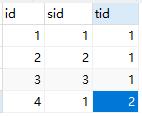MyBatis多表联查
Posted Tomas曼
tags:
篇首语:本文由小常识网(cha138.com)小编为大家整理,主要介绍了MyBatis多表联查相关的知识,希望对你有一定的参考价值。
这篇文章写了以下几个简单的例子,用来说明MyBatis多标联查基本语法
1.sql片段的用法
2.一对多查询
3.多条sql的一对多查询
4.多对一查询
5.多条sql一对多查询
6、多对多查询
这里沿着接口→小配置的路线写了,测试类就是遍历输出结果:
一、接口:
1 package cn.sohappy.acourses.course0921; 2 3 import cn.sohappy.acourses.bean.BillManyToOne; 4 import cn.sohappy.acourses.bean.UserOneToMany; 5 import cn.sohappy.bean.Smbms_user; 6 7 import java.util.List; 8 9 public interface IUserDAO { 10 //01.sql片段,查询所有user 11 List<Smbms_user> findAll(); 12 //02.oneToMany,传入user,返回包含账单信息的user 13 UserOneToMany getUserOneToManyBills(UserOneToMany user); 14 //03.oneToMany,多条sql查询,传入user,返回包含账单信息的user 15 UserOneToMany getUserOneToManyBillsMultiSQL(UserOneToMany user); 16 //04.manyToOne,传入bill,返回包含用户信息的bill 17 BillManyToOne getBillManyToOneUser(BillManyToOne bill); 18 //05.manyToOne,多条sql查询,传入bill,返回包含用户信息的bill 19 BillManyToOne getBillManyToOneUserMultiSQL(BillManyToOne bill); 20 }
二、小配置
先实现第一个方法
1、List<Smbms_user> findAll();查询所有user的编号,名字,密码
小配置的配置头

<?xml version="1.0" encoding="UTF-8" ?> <!DOCTYPE mapper PUBLIC "-//mybatis.org//DTD Mapper 3.0//EN" "http://mybatis.org/dtd/mybatis-3-mapper.dtd"> <mapper namespace="cn.sohappy.acourses.course0921.IUserDAO"> <!--此处是代码--> </mapper>
以下省略配置头
<sql id="columns"> userCode,userName,userPassword </sql> <resultMap id="mUser" type="cn.sohappy.bean.Smbms_user" autoMapping="false"> <id property="username" column="userName"/> <result property="userpassword" column="userPassword"/> <result property="usercode" column="userCode"/> </resultMap> <!--用<include refid="columns"/>代替*--> <select id="findAll" resultMap="mUser"> select <include refid="columns"/> from smbms_user </select>
2、UserOneToMany getUserOneToManyBills(UserOneToMany user);
查询某个用户的账单信息,首先将账单List植入用户类中(第11行)
1 package cn.sohappy.acourses.bean; 2 3 import java.util.List; 4 5 public class UserOneToMany { 6 private Long id; 7 private String usercode; 8 private String username; 9 10 //a user has lots of bills 11 private List<BillManyToOne> bills; 12 13 //getter and setter 14 }
小配置代码:
resultMap中property是对象的属性名,column是数据表中的字段名。collection是UserOneToMany对象中植入的泛型集合属性List<BillManyToOne> bills
语法是:<collection property="bills" ofType="cn.sohappy.acourses.bean.BillManyToOne">...code...</collection>
1 <!--02.oneToMany--> 2 <resultMap id="UserOneToManyBills" type="cn.sohappy.acourses.bean.UserOneToMany" autoMapping="false"> 3 <id property="id" column="u_id"/> 4 <result property="username" column="userName"/> 5 <collection property="bills" ofType="cn.sohappy.acourses.bean.BillManyToOne"> 6 <id property="id" column="b_id"/> 7 <result property="productname" column="productName"/> 8 <result property="billcode" column="billCode"/> 9 </collection> 10 </resultMap> 11 <select id="getUserOneToManyBills" resultMap="UserOneToManyBills"> 12 <!--不好,id重名了,起个别名吧--> 13 select smbms_user.id as u_id,userName,smbms_bill.id as b_id,productName,billCode from smbms_user,smbms_bill 14 where smbms_user.id=smbms_bill.createdBy and userCode=#{usercode} 15 </select>
3、UserOneToMany getUserOneToManyBillsMultiSQL(UserOneToMany user);
该方法通过多条sql查询user和其账单
小配置代码:其中#{**}是占位符
1 <!--03.oneToMany多条sql--> 2 <resultMap id="UserOneToManyBillsMultiSQL" type="cn.sohappy.acourses.bean.UserOneToMany" autoMapping="false"> 3 <id property="id" column="id"/> 4 <result property="username" column="userName"/> 5 <!--下行的select为第二条sql名,column为第一条sql的字段名,其唯一值作为第二条sql的条件--> 6 <collection property="bills" ofType="cn.sohappy.acourses.bean.BillManyToOne" select="selectBillsByUser" column="id"/> 7 </resultMap> 8 <select id="selectBillsByUser" resultType="cn.sohappy.acourses.bean.BillManyToOne"> 9 select * from smbms_bill where createdBy=#{**} 10 </select> 11 <select id="getUserOneToManyBillsMultiSQL" resultMap="UserOneToManyBillsMultiSQL"> 12 select * from smbms_user where userCode=#{usercode} 13 </select>
4、BillManyToOne getBillManyToOneUser(BillManyToOne bill);
传入bill,返回包含用户信息的bill,这里需要在bill类中植入user属性及相应getter and setter:private UserOneToMany user;
小配置代码:这里使用的语法是:<association property="user" javaType="cn.sohappy.acourses.bean.UserOneToMany">...code...</association>
1 <!--04.manyToOne--> 2 <resultMap id="BillManyToOneUser" type="cn.sohappy.acourses.bean.BillManyToOne" autoMapping="false"> 3 <id property="id" column="b_id"/> 4 <result property="billcode" column="billCode"/> 5 <association property="user" javaType="cn.sohappy.acourses.bean.UserOneToMany"> 6 <id property="id" column="u_id"/> 7 <result property="usercode" column="userCode"/> 8 <result property="username" column="userName"/> 9 </association> 10 </resultMap> 11 <select id="getBillManyToOneUser" resultMap="BillManyToOneUser"> 12 select smbms_user.id as u_id,userCode,userName,smbms_bill.id as b_id,billCode from smbms_user,smbms_bill 13 where smbms_user.id=smbms_bill.createdBy and billCode=#{billcode} 14 </select>
5.BillManyToOne getBillManyToOneUserMultiSQL(BillManyToOne bill);多条sql多对一查询
小配置代码:
1 <!--05.manyToOne多条sql--> 2 <resultMap id="BillManyToOneUserMultiSQL" type="cn.sohappy.acourses.bean.BillManyToOne" autoMapping="false"> 3 <id property="id" column="id"/> 4 <result property="billcode" column="billCode"/> 5 <association property="user" javaType="cn.sohappy.acourses.bean.UserOneToMany" autoMapping="false" select="selectUserByCreatedBy" column="CreatedBy"> 6 <id property="id" column="id"/> 7 <result property="usercode" column="userCode"/> 8 <result property="username" column="userName"/> 9 </association> 10 </resultMap> 11 <select id="selectUserByCreatedBy" resultType="cn.sohappy.acourses.bean.UserOneToMany"> 12 select * from smbms_user where id=#{**} 13 </select> 14 <!--这里需要查找公共字段createdBy作为association中的column参数--> 15 <select id="getBillManyToOneUserMultiSQL" resultMap="BillManyToOneUserMultiSQL"> 16 select id,billCode,createdBy from smbms_bill where billCode=#{billcode} 17 </select>
最后写下多对多查询
其实多对多查询和一对多查询是一样的,只不过表中可能没有公共字段,要借助第三张表。
举个例子:根据老师id查询他所教授学生的id
下面建立三张表:
这是student表

这是老师表

这是第三张表

步骤和一对多是一样的,先生成实体类,然后在老师中植入学生List
创建接口,写个方法:
1 package cn.sohappy.acourses.course0923; 2 3 import cn.sohappy.acourses.bean.Teachert14; 4 5 public interface ITeacherDAO { 6 Teachert14 findStudentsByTeacher(Teachert14 teacher); 7 }
下面直接写小配置了:
1 <?xml version="1.0" encoding="UTF-8" ?> 2 <!DOCTYPE mapper 3 PUBLIC "-//mybatis.org//DTD Mapper 3.0//EN" 4 "http://mybatis.org/dtd/mybatis-3-mapper.dtd"> 5 <mapper namespace="cn.sohappy.acourses.course0923.ITeacherDAO"> 6 <resultMap id="mTeacher" type="cn.sohappy.acourses.bean.Teachert14"> 7 <id property="tid" column="tid"/> 8 <result property="tname" column="tname"/> 9 <collection property="studentt14s" ofType="cn.sohappy.acourses.bean.Studentt14"> 10 <id property="sid" column="sid"/> 11 <result property="sname" column="sname"/> 12 </collection> 13 </resultMap> 14 <select id="findStudentsByTeacher" resultMap="mTeacher"> 15 select studentt14.sid,sname,teachert14.tid,tname from studentt14,teachert14,teacher_studentt14 16 where studentt14.sid=teacher_studentt14.sid and teachert14.tid=teacher_studentt14.tid 17 and teachert14.tid=#{tid} 18 </select> 19 </mapper>
最后附上测试类和MyBatis工具类:
测试类:
1 package cn.test; 2 3 import cn.sohappy.acourses.bean.Studentt14; 4 import cn.sohappy.acourses.bean.Teachert14; 5 import cn.sohappy.acourses.course0923.ITeacherDAO; 6 import cn.sohappy.util.MyBatisUtil; 7 import org.apache.ibatis.session.SqlSession; 8 import org.junit.Test; 9 10 public class test20170923 { 11 //多对多,借助第三张表 12 @Test 13 public void findStudentsByTeacher(){ 14 SqlSession session = MyBatisUtil.getSession(); 15 ITeacherDAO mapper = session.getMapper(ITeacherDAO.class); 16 Teachert14 teachert14 = new Teachert14(); 17 teachert14.setTid(1L); 18 Teachert14 teacher = mapper.findStudentsByTeacher(teachert14); 19 for (Studentt14 item:teacher.getStudentt14s()) { 20 System.out.println(item.getSname()); 21 } 22 } 23 }
MyBatis工具类:
1 package cn.sohappy.util; 2 3 import org.apache.ibatis.io.Resources; 4 import org.apache.ibatis.session.SqlSession; 5 import org.apache.ibatis.session.SqlSessionFactory; 6 import org.apache.ibatis.session.SqlSessionFactoryBuilder; 7 8 import java.io.IOException; 9 import java.io.InputStream; 10 11 public class MyBatisUtil { 12 private static InputStream is; 13 private static SqlSessionFactory sqlSessionFactory; 14 static { 15 try { 16 is=Resources.getResourceAsStream("mybatis-config.xml"); 17 } catch (IOException e) { 18 e.printStackTrace(); 19 } 20 sqlSessionFactory= new SqlSessionFactoryBuilder().build(is); 21 } 22 private MyBatisUtil(){} 23 public static SqlSession getSession(){ 24 return sqlSessionFactory.openSession(); 25 } 26 }
以上是关于MyBatis多表联查的主要内容,如果未能解决你的问题,请参考以下文章
